
Do you have a question about the YASKAWA Varispeed-616G3 and is the answer not in the manual?
| Output Voltage | 0 to Input Voltage |
|---|---|
| Control Method | V/f Control, Vector Control |
| Cooling Method | Forced air cooling |
| Type | Inverter |
| Power Range | 0.4 kW to 15 kW |
| Frequency Range | 0 to 400 Hz |
| Protection Features | Overcurrent, overvoltage, undervoltage, overload, short circuit, ground fault, overheating |
| Communication Interface | RS-485, Modbus |
| Operating Temperature | -10 to 50 °C |
| Storage Temperature | -20 to +60°C (-4 to 140°F) |
| Humidity | 5 to 95% (non-condensing) |
| Altitude | Up to 1000 m |
| Weight | Varies depending on model |
| Input Voltage | 3-Phase 200-240VAC, 380-480VAC, 500-600VAC (depending on model) |
Warnings about high voltage, capacitor discharge, connections, grounding, and operation.
Cautions on factory settings, dielectric tests, static discharge, and terminal tightness.
Identifies the front cover and digital operator on the unit.
Procedure for checking the received product against order and for transit damage.
Information on nameplate data and model designation breakdown.
Warnings regarding safe handling, lifting, and avoiding drops of the inverter.
Requirements for vertical mounting and clearance for effective cooling.
Criteria for selecting an installation area: protection from elements, dust, vibration, and temperature.
Specifies allowable ambient temperatures for operation and storage.
Overview of the interconnection diagram for main and control circuits.
Detailed terminal numbering and signal functions for control circuits.
Important notes and cautions for connecting control circuit terminals.
Details of main circuit terminals, input/output, and connection diagrams for voltage classes.
Recommendations for MCCB and fuse ratings for branch circuit protection.
Guidelines for connecting surge suppressors to coils of relays and contactors.
Table specifying wire sizes, screws, and types for 230V class connections.
Table specifying wire sizes, screws, and types for 460V class connections.
Guidance on selecting wire size to limit voltage drop to less than 2%.
Cautions for external wiring, including noise prevention and short-circuit avoidance.
Detailed instructions and diagrams for proper grounding of the inverter unit.
Description of signal functions, levels, and types for control circuit terminals.
Diagram illustrating the physical arrangement of control circuit terminals.
Guidelines for separating control and main circuit wiring to prevent noise interference.
Recommendations for using shielded wire and connecting its shield to terminal 12.
Important safety step: disconnect machine coupling before initial operation.
List of checks (wiring, terminals, clippings, load) before test operation.
Procedure to set the input voltage jumper for 460V class units.
Explanation of DRIVE and PRGM modes for inverter operation and programming.
Overview of the digital operator's keys, LEDs, and display functions.
Diagram showing how to switch between DRIVE/PRGM modes and display faults.
Details on what is displayed in DRIVE mode, including fault history and monitor items.
Guide to PRGM mode navigation, data display, and setting changes.
Constants for monitoring inverter status like frequency, voltage, and output.
Constants related to master frequency and jog frequency settings.
Constants adjustable during operation, such as acceleration and deceleration times.
Constants for system configuration and control parameters like braking and limits.
Step-by-step guide to setting the input power supply voltage using the operator.
Flowchart illustrating the sequence of operations using the digital operator.
Guide to powering on, setting frequency, and checking rotation direction.
Detailed steps for setting frequency and executing forward runs.
Detailed steps for setting frequency and executing reverse runs and stops.
Procedure for controlling the inverter using external control terminals.
Table and notes for periodic checks of terminals, cooling fins, circuit boards, fans, and power elements.
Table listing fault indications, descriptions, and recommended corrective actions.
Details on faults associated with option cards and communication errors.
Cautionary advice for handling specific faults like 'FU' faults.
Comprehensive technical specifications for 200-230V class Varispeed-616G3 inverters.
Comprehensive technical specifications for 380-460V class Varispeed-616G3 inverters.
Summary of built-in protective functions such as overload, overvoltage, and undervoltage.
Details on ambient temperature, storage temperature, humidity, and vibration limits.
Table detailing the physical dimensions (W, H, D, etc.) for open chassis models.
Table detailing the physical dimensions (W, H, D, etc.) for enclosed models.
Selection charts for V/f patterns based on application and motor characteristics.
Selection charts for V/f patterns for higher HP ratings based on application.
Guidelines for selecting V/f patterns considering motor characteristics and operating conditions.
Wiring diagram for 230V class models, including braking units.
Wiring diagram for 460V class models, including braking units.
Wiring diagram for controlling run/stop using a main circuit magnetic contactor.
Diagram showing connections when using the JVOP-95 VS Operator.
Diagram showing connections when using the JVOP-96 VS Operator.
Wiring diagram for operation signals using transistor open collector configuration.
Wiring diagram for utilizing contact and photo-coupler outputs.
Details on analog and digital speed reference cards for enhanced control.
Information on analog monitor, pulse monitor, and digital output cards.
Information on PG cards for speed feedback compensation.
Diagram showing the physical location for installing option cards on the control board.
Description of Digital Monitor and Remote Operator units for remote control/monitoring.
Details on VS Operator units for remote frequency setting and start/stop.
Information on Braking Units and Back up Capacitor Units for power loss.
Description of Control Power Units for DI-16G and PG-C cards.
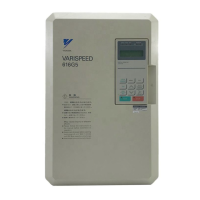
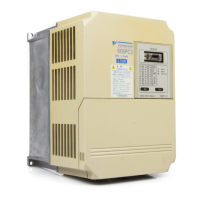
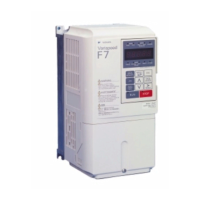
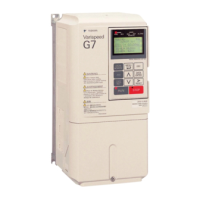
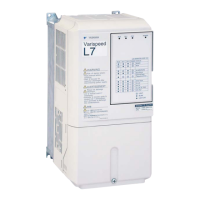
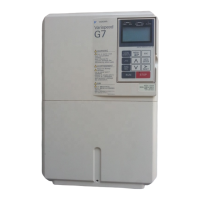
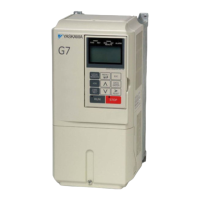

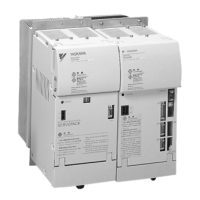

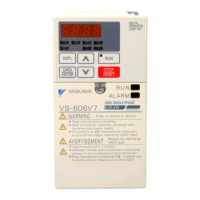
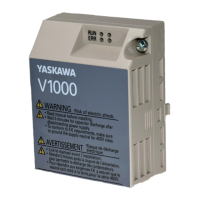
